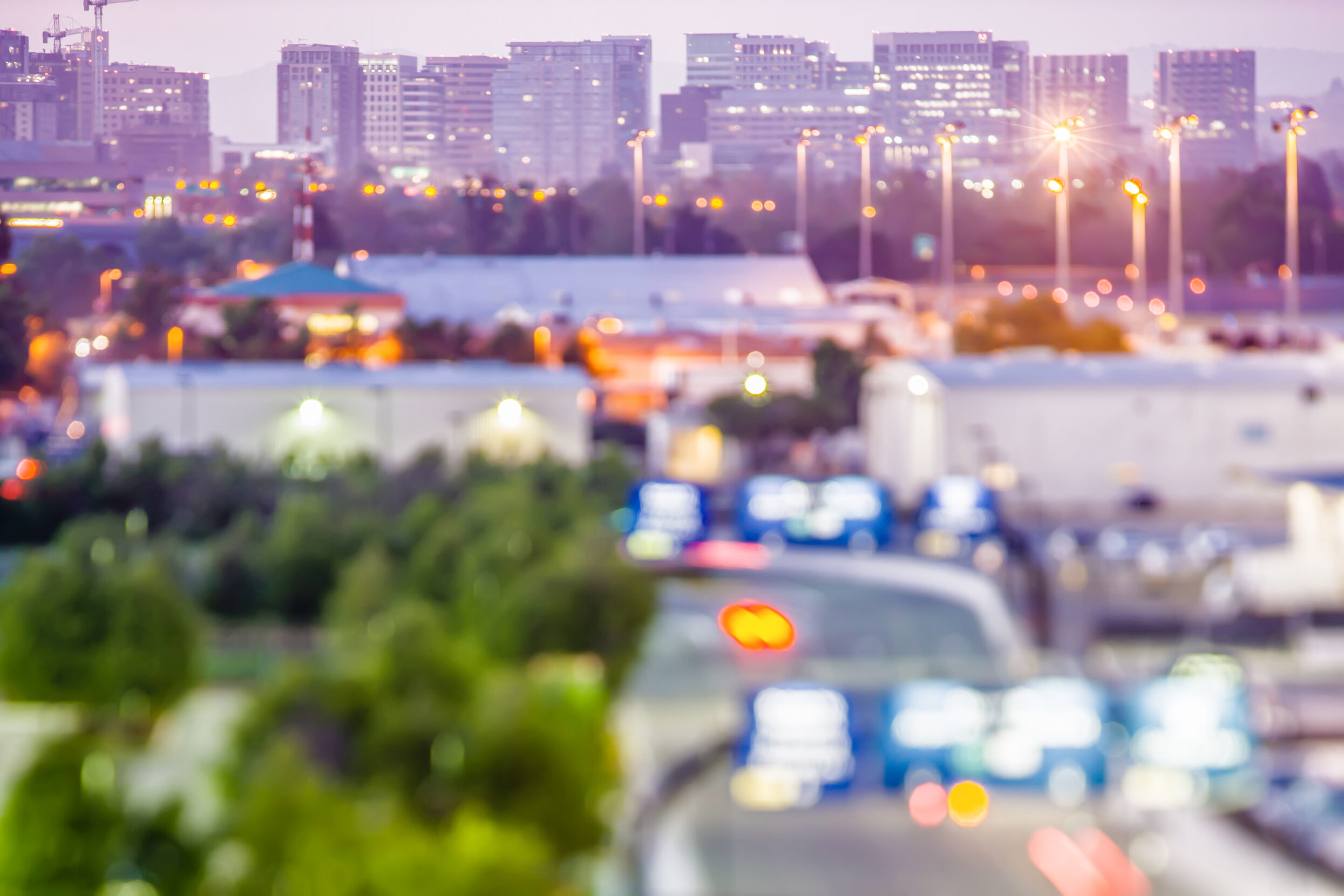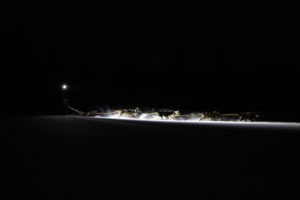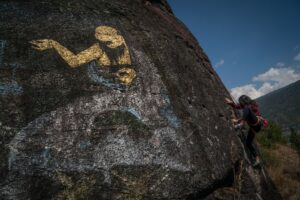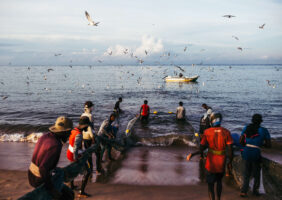Support Hidden Compass
Our articles are crafted by humans (not generative AI). Support Team Human with a contribution!
At the Jalandhar train station, dead bodies littered the platform. Inside, hundreds of others hid in waiting rooms with only the clothes on their backs. The rains were late that year, and even from nearby villages, one could see smoke rising from the city.
“It was summer and we slept on the roof, on charpais, and you could see that the city was burning,” recalls Khan Hussan Zia during an interview with the 1947 Partition Archive, an oral history project.
“There was a lot of disturbances, riots, and killings, and Jalandhar City, half of it was burning at that time,” Zia said.
When the British abandoned the remains of their empire, they partitioned the subcontinent into India, Pakistan, and East Pakistan (now Bangladesh), geographically dividing the land along widely opposed religious lines. Anywhere from 14 to 20 million people were forcibly displaced from their ancestral neighborhoods and then relocated to the other side of the new border, creating the largest single mass migration event in human history.
As Hindus and Sikhs left Pakistan for India, Muslims traveled in the opposite direction, and everyone seemingly turned on each other. Entire trains were ambushed along the migration routes, only to arrive at their destination filled with corpses. Whole villages went up in flames. Thousands of women and children were abducted. The official numbers are unverifiable, but most put the number of deaths around two million. Many people witnessed or even participated in these horrific events yet kept silent about them for decades. Somehow, they lived with immense trauma, sadness, and longing for their former homeland, which was now a different country — a homeland that countless were not allowed to visit.
In Jalandhar, India, many Muslims knew they had to leave for their own safety. Thousands were herded into a refugee camp.
“From there, in parts, they moved to Pakistan, mostly by road, on foot, in ox carts …,” Zia said. “Terrible things happened, but I don’t want to go into it because it disturbs me. It never leaves you, these kinds of memories.”

An overcrowded train transporting refugees during the Partition of India. When the British left in August 1947, they sparked the single largest mass migration event in human history — and an onslaught of violence that claimed millions of lives. Photo: Unknown.
~~
Somewhere in all of that, 11-year-old Gurdial Singh, the youngest of three Sikh brothers in Jalandhar, was witnessing the violence. That same year, he cried because one of his best friends, a Muslim boy, was forced to relocate to a brand-new country, Pakistan, on the other side of a brand-new border that few wanted.
Gurdial did not have to move, and in the years that followed, he continued to get good grades at Government Model School in Jalandhar, excelling in English, math, and geography. He played soccer in the streets, studied chess openings, and sang in a children’s choir on All India Radio.
Gurdial didn’t need to go anywhere. But, at age 17, he went all the same.
On Christmas Day, 1953, Gurdial boarded a Pan Am flight in Delhi at 3:30am. The itinerary took him through London, New York, and then to Los Angeles. When he arrived at the house of a family friend in Sacramento, the friend exchanged letters with Gurdial’s dad to let him know Gurdial had arrived safely. A return letter from his dad mentioned that Gurdial’s mom had been weeping ever since he left.
By the time he finished his math degree at San Jose State College and married a librarian named Alice, Gurdial had already once been convicted of drunk driving and was awaiting trial on another alcohol-related crime: a hit-and-run collision with a parked car.
He never spoke of what he saw in Jalandhar as a child.
~~
In the middle of Jalandhar, a cacophony of traffic noise fills the airspace at Jyoti Chowk, a congested roundabout right on the old Grand Trunk Road. I hear a frequency range of horns — shrill monotones, belching gusts, and tinny buzz-claps, plus a dozen scooter engines.
The vehicular mass includes not just cars but every possible variety of rickshaw — covered and uncovered, small three-wheelers, and larger family-sized contraptions — as well as vibrantly painted cargo trucks, convoys of scooters, and a few cows.
A beautifully incongruous clutter of structures encircles the roundabout, while a few clogged roads spin off in different directions. The commerce seems lively and rocking: garments, melons, watches, and cosmetics. Distorted Punjabi music blasts from jewelry stores. Colorful fabrics hang from rickety racks that overflow into the street.
Gurdial Singh grew up on the other side of this roundabout. He never told me anything about India, which is why I am here, chasing my dad’s past, ingesting aromas of motor oil and incense.
My cousin Gogi is showing me around. We look similar. He resembles my dad, and I resemble our grandfather.
Most of the city’s natives eventually arrived at a point in life when everything recognizable from their childhood was now gone.
After parking down the street behind a brick building and a wrought iron gate, Gogi and I weave our way toward my dad’s childhood home, which, surprisingly, still exists.
“That roundabout was here in the 1960s as well,” Gogi says, pointing back toward the main street.
I never knew my dad grew up right on the old Grand Trunk Road, the ancient route that still runs from modern-day Bangladesh, across northern India and Pakistan, and through the Khyber Pass to Kabul, Afghanistan. It’s one of the oldest, most documented, and dangerous trade routes in human history. For more than 2,000 years, invaders, armies, killers, and caravans all claimed it as their own.
In my dad’s childhood days, when Jalandhar was still a small town surrounded by fields, the ancient road ran straight through the center of town. Today, the city’s population is well over a million, but this particular stretch of road remains.
My dad was not a forcibly displaced person. He came to the United States voluntarily. His journey was not comparable to the journeys of refugees. But as an eleven-year-old in Jalandhar during Partition, he must have witnessed something terrible. I never got the chance to ask him about it. He passed away when I was 16, succumbing to alcoholism and leaving me with a crater-sized hole in my own family history.
~~
To me, the travel writer’s profession seemed perfectly suited for abandonment and loss. Former haunts of dead authors often became my subject matter. I prowled around cemeteries and gravesites. The childhood home of Italian poet Giovanni Pascoli, whose dad was murdered when Giovanni was young, appeared in one story, teaching me how a poet could transform his own childhood trauma into a creative career.
In my hometown of San José, California, my job was to scour ignored “alleys” or anything “off the beaten path,” not just in terms of geography, but also in terms of history or subject matter. I wrote a creative newspaper column every week, often obsessing over places the city had allowed to disappear.
San José was a postmodern suburb of a million people, with landlords, politicians, and real estate syndicates wiping out buildings or entire blocks — sometimes even the same blocks — over the course of decades. Victorian houses were moved around like chess pieces to suit the latest whims of developers. Historical structures were bulldozed in favor of chain restaurants.
In San José, this was standard operating procedure. Most of the city’s natives eventually arrived at a point in life when everything recognizable from their childhood was now gone. I had come to understand my city in terms of endless creation and destruction and creation.
Beyond the counter, I see crumbling food-service machinery, tangles of wiring, makeshift pipes, and assorted kitchen bric-a-brac.
As a result, I felt more at home in the library, flipping through tattered old city directories to uncover who or what previously existed at various street addresses decades earlier, just so I could merge the physical landscape with the temporal landscape. I was assured this was an excellent creative device in which to wrap a story: Walk through a dilapidated strip mall, talk about the history, the looming condo developments, and merge personal memories with architectural history, shattering all timelines. Boom. Newspaper column.
After writing hundreds of these, I went ballistic anytime a real estate developer carved up the landscape. Any example of displacement sent me through the roof. When author Viet Thanh Nguyen spoke about San José replacing his parents’ market with a parking lot, my resultant column blasted the city’s “bumbling ineptitude.” As refugees, his parents had already lost their own country before building one of the first Vietnamese grocery stores in San José. Now the city had wiped out the whole block.
The anger and the loss didn’t feel normal. They felt centuries old.

For author Gary Singh, the constant development and redevelopment of his hometown, San José, California, elicited an anger he couldn’t quite explain. Photo: Zoonar GmbH / Alamy.
~~
For her 2022 book, In the Language of Remembering, historian Aanchal Malhotra interviewed numerous descendants of Partition survivors. In the book, they describe strange feelings of second-hand loss because their grandparents never told them what happened during Partition. Descendants felt like a part of their own history was missing because it had been silenced. One young woman described an “unexplainable proxy loss” she felt for pre-Partition India.
That phrase — unexplainable proxy loss — imprinted itself on my brain. It describes what I’ve also felt: a bizarre, nostalgic longing for landscapes that no longer exist. I longed for them so much that I devoted much of my adult life to pursuing such landscapes as a professional travel writer. And even though I was born more than 20 years after Partition, I felt a tremendous sense of loss for this formerly undivided place.
I never got the chance to ask him about it.
Over the last several years, psychiatrists and neuroscientists have studied how those who’ve experienced trauma could pass on the effects to future generations, influencing the offspring in numerous ways — even if the traumatic events happened long before the offspring were born.
“One of the best examples of that is the Holocaust, and even more recent, detainees at the border, separated from their children, or people who experienced the wars in Iraq, or anyone who has experienced any kind of disaster trauma,” explains Jason Murphy, a psychotherapist and founder of Trauma Resolution Therapy in Los Angeles. “The nervous system may be altered in the next generation. There’s intergenerational trauma, a lot of which is more behavioral, but also, it ties into epigenetics. Quite literally, the gene expression from one generation that has experienced trauma to the next generation becomes altered.”
~~
We arrive at the opposite side of the roundabout to see a ramshackle fruit stand jammed into the street level of a gutted, three-story concrete and brick building. Two graying Sikh men in sweater vests are cramming bananas and papayas into blenders. Bowls of carrots, green melons, and other fruit I do not recognize sit atop stacks of empty plastic crates, which function as the counter. The traffic is so loud I can’t even hear the blenders.
Beyond the counter, I see crumbling food-service machinery, tangles of wiring, makeshift pipes, and assorted kitchen bric-a-brac. Sketchy light bulbs hang from unidentifiable places, and Guru Nanak posters dot the walls. Whatever this space used to be, it is now transformed.
I can’t speak a word of Punjabi, so I offer only a dumb smile when Gogi introduces me to the two men in the fruit stand. Their family owns this building, where my dad grew up. For much of the 20th century, my dad’s parents lived upstairs in the two now-gutted levels above, renting their home for next to nothing by today’s standards. The two old men smile at me, revealing weathered sets of teeth. They remember my grandfather from the 1960s. This is officially my ancestral house, even though it isn’t a house anymore.
~~
The rains were late that year, and even from nearby villages, one could see smoke rising from the city.
Somehow, after years of looking up former inhabitants of various buildings in San José, those old tattered city directories took on a therapeutic role. I realized who I really should be searching for.
In the library, I pulled out the bulky directory books for 1958-1960 and opened them up on the long flat tables. I ran my index finger down the pages, through the ‘S’ surnames, and there he was. My dad.
After Gurdial Singh landed in San José to attend college, he was displaced not once but twice in just a couple of years. His flat was destroyed so the school could build a parking garage, after which he briefly moved across the street to a building that was then also torn down.
Maybe I really had inherited emotions of some sort.
Then, in 2022, on a routine afternoon hang with my mom, Alice, a now-retired librarian who still lived in the same tract house where I grew up, I found some dusty boxes of slides tucked away on the upper shelf of a closet. They hadn’t been touched in decades. What I found in the boxes finally sent me back to India.
~~
In 1965, before I was born, my parents traveled the world, including six weeks in India to meet my dad’s family. I never knew any photos existed until the moment I discovered those hundreds of slides in my mom’s closet. Many of the slides were still in black plastic carousels, covered in dust. Others were haphazardly jammed in a faded yellow Kodak box. The slides were in the house the whole time I was growing up, yet I never saw them. My mom forgot they were even still there.
After developing the slides, I spend hours looking at the digitized images.
Several slides depict my father, on this same 1965 trip, drinking with his friends and family in his childhood home, where his parents still lived at the time. My grandparents and uncles appear in the photos — dark hair and eyes, most of the men with beards. Laughing, joking, and half-drunk, everyone is sitting on rattan chairs around a knee-high table at the center of the room. A bottle of whisky, a silver jug of water and several glasses, along with empty plates of food and newspapers, cover the table.

Gurdial Singh visits with his family in Jalandhar, India, in 1965. For Gurdial’s son, Gary, the discovery of this picture and others spurred him to visit India for the first time in nearly four decades. Photo: Courtesy of Gary Singh.
In the photos, my father is the only man without a turban. Even at home, I never once saw him wear one.
“He never wore a turban,” my mom says, as we flip through the photos, crouching over her computer desk in the back room of her house. “He wouldn’t do it,” she adds. “He thought it was too religious. And he hated religion.”
~~
To the immediate right of the fruit stand at Jyoti Chowk, Gogi points to a narrow concrete stairway that leads up from the sidewalk to the floors above. That’s where my dad lived as a child, Gogi tells me. Up there.
The upper levels are not currently inhabited, so the two old men allow us to go up and have a look.
Standing at a chaotic roundabout with the smell of fresh papaya shakes drifting through the air, I felt a crippling sense of shame that I’d never bothered to ask about any of this. Why did it take me this long? With Gogi behind me, I begin to ascend the concrete staircase.
Upstairs, I still hear the traffic because the levels are open-air. There are no windows, only waist-high walls allowing me to see out into the urban landscape. Examining the room, I see piles of junk and storage materials: discarded fruit crates, folded up resin tarps, broken mannequins, shelving, slabs of wood, scrap metal, and buckets of tools. A layer of cement dust, seemingly an inch thick, covers everything.
I fixate on the brick wall. I know that wall.
I have never been here, but the brickwork is familiar. I’d seen it in those 1965 pictures of my father drinking with his family and friends.
I am standing in what is left of his childhood home.
Laughing, joking, and half-drunk, everyone is sitting on rattan chairs around a knee-high table at the center of the room.
Renovations are underway, and the adjoining wall has been replaced, but the bones of the structure are the same.
On my phone, I pull up the old photos of this room, photos from before I was even alive, and compare them to the current space.
Many of the 1965 photos show the interior of the family house from different angles, and even views of the traffic roundabout below. Inside, the floor was concrete, the walls brick. In the middle of the room, vertical columns, also brick, ran from floor to ceiling. Additional slides show my parents, along with my dad’s entire family, as they all were 60 years ago. In the photos, my cousin Gogi, then four years old, either scampered about the room or sat on my dad’s lap.
In 1988, three years after my father died, I traveled to India to take his place at Gogi’s wedding. That was the last time I was in Jalandhar. Now, decades later, Gogi begins pointing energetically to various corners of the room, then to the equivalent places in the photos on my phone. He hasn’t been up here in decades, but he remembers everything. We then scramble to stage a photo of me standing in the exact same spot where my dad and his friends once sat around a table.
As I poke around in my dad’s childhood home from half a century earlier, I cannot process the degree of overwhelm I feel.
I can’t tell if I am crying or not.
Needing to tell everyone back home in California, I immediately upload the 1965 photo to Facebook, right alongside the one of me standing there in the current moment. A flurry of comments appears within moments.
“It’s funny how we can have a connection to our past, even though it wasn’t a part of our ‘lived’ life,” says one commenter. “That whiff of remembrance for something you know is a part of you resonates so deeply.”
She is right.
The history I had avoided for much of my life is right here: in a janky building on one of the oldest thoroughfares in Asia. It is exactly the type of time-space juxtaposition I’ve used for years as a creative device. Boom. Newspaper column.
~~
With only a few days left before I fly back home, Gogi drives me to Dosanjh Kalan, a village with a population of maybe 4,000, about 20 miles southeast of Jalandhar. As we travel the two-lane country road to the village, patchworks of lush green farmland sprawl for miles in every direction.
Another cousin of mine, with the Anglicized name of Paul, has traveled from England to join me. He is now in the car with us. He and Gogi both tell me that Dosanjh Kalan is my ancestral village, and that my grandfather grew up here.
“Your dad, he came to play in the streets here,” Paul says.
Other than that, I know only that a historian lives here, somewhere, and my cousins want to find him.
Inside the gates, beautifully incongruous buildings flank cobblestone alleys. Ornate concrete balconies overlook the alleys. Other buildings are more downtrodden, with corrugated metal doors and crooked windows. A solitary bicycle leans up against a paint-peeled brick house. Stray dogs sprawl out on the pavement, soaking in the sun. Children poke their heads from irregularly shaped windows. We see hardly anyone else.
My cousins then explain that we were here to meet “Principal” Gian Singh Dosanjh, the village historian, who we hope will tell us about our family heritage. My cousins spoke to him a few days earlier, mentioning that they were interested in stopping by. They’ve never met him, but since I am in Punjab for the first time in decades, they are trying to track him down.
It isn’t working. But after pulling over and banging on a few doors, we encounter someone who apparently knows where the historian lives. He motions with an outstretched arm, palm open, in a pleasantly condescending gesture that simply means, “It’s somewhere in that direction.”
Eventually, we arrive at the correct address. A short, scholarly-looking man wearing a red turban, thick black glasses, and a light gray sweater opens the door.
Principal beckons us inside, where extensive remodeling is underway. Scaffolding, dust, and building supplies lay scattered about the front hallway. A few workers loiter in the foyer, smoking cigarettes. Everywhere we’d been on this trip, it seemed things were being overhauled.
We follow Principal into the next room, where he pulls a few rattan chairs out of nowhere and distributes them around a knee-high table. He briefly disappears down the hallway and returns with a few handwritten family trees and a pile of his books, placing them on the table between us all. He tells us he wrote a book on the entire history of Dosanjh Kalan: Encased in a flimsy plastic cover, the book is a blue hardback volume with cover photos of various Sikh temples around Dosanjh Kalan.
My cousins explain that I am from the U.S. and am here to reconnect with my roots. This feels like an exaggeration. I really have no idea why I am here, or even what anyone is saying most of the time.
Principal points to one of the village family trees he’d spent years researching, a large white piece of paper with black ink. Right there in the tree, in Principal’s Gurmukhi script, is my father’s name, along with my two late uncles, and my grandfather, Bawa Singh. My dad’s name is even mentioned in the book of village history that Principal wrote. He flips through a bunch of pages and then points it out to me.
And there he was. My dad.
Before today, Principal didn’t know some long-haired wacko from California would roll in and just happen to be the son of someone in a family tree he’d already compiled.
Then, pulls out a pen and adds me to the family tree.
The rest of the group continues speaking at full volume in Punjabi, but I am emotionally spent. I slump back in the chair.
I think about all my previous bylines — more than 1,500 columns, features, and international travel stories, plus my exploration of San José — its ghosts, janky buildings, and displacement. All of it. The entire body of work I’d produced throughout my adult life was just me trying to find my way back to India. The unexplainable proxy loss is becoming more explainable.
We leave Principal’s home with multiple copies of his Dosanjh history book. As we bid farewell, palms together in front of our chests, I suddenly remember how to say Sat Sri Akal — Truth is the Timeless One — the standard Sikh goodbye.

Gary poses for a photo in what is left of his ancestral home in Jalandhar. Photo: Courtesy of Gary Singh.
*Correction: A previous version of this story included a mispelling of historian Aanchal Malhotra’s last name.
Gary Singh
Gary Singh is the author of three books, including an anthology of his newspaper columns, Silicon Alleys, published in 2020.



